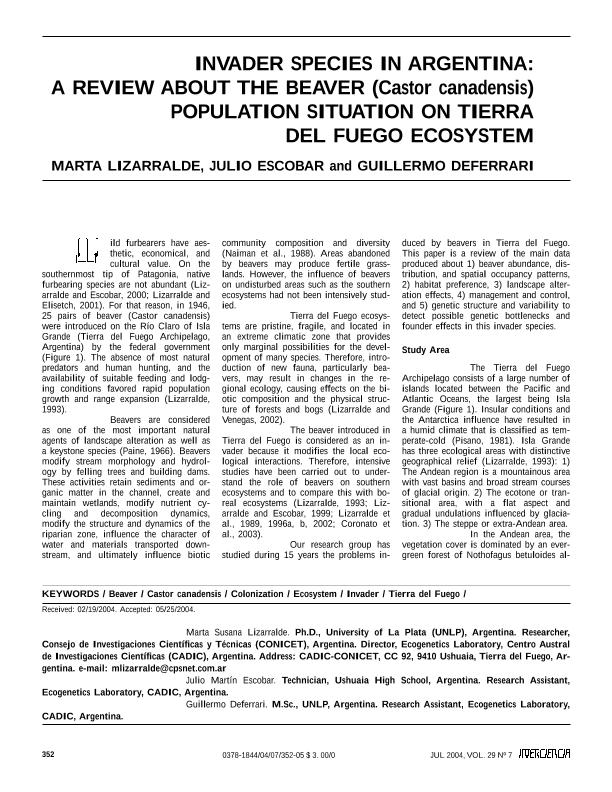Mostrar el registro sencillo del ítem
dc.contributor.author
Lizarralde, Marta Susana

dc.contributor.author
Escobar, Julio Martin

dc.contributor.author
Deferrari, Guillermo Alejandro

dc.date.available
2022-07-25T13:23:14Z
dc.date.issued
2004-12
dc.identifier.citation
Lizarralde, Marta Susana; Escobar, Julio Martin; Deferrari, Guillermo Alejandro; Invader species of Argentina: A review about beaver (Castor canadensis) population situation on Tierra del Fuego ecosystem; Interciencia; Interciencia; 29; 7; 12-2004; 352-356
dc.identifier.issn
0378-1844
dc.identifier.uri
http://hdl.handle.net/11336/162998
dc.description.abstract
Beavers (Castor canadensis) were introduced on Isla Grande of Tierra del Fuego, Argentina, in 1946. The suitable feeding and lodging sites coupled with the lack of natural predators or competitors favored rapid population growth and range expansion. This paper shows current population status and landscape modifications induced by beaver in these southern ecosystems. Beaver now occur in all streams in the Andean and extra-Andean areas and nearly all aquatic habitats on Isla Grande as well as other Chilean islands of Tierra del Fuego archipelago (70,000 km2). Low-gradient areas on small streams were more densely occupied than those of the slope valleys. Densities were similar to those in the Northern Hemisphere. Extensively colonized habitats showed 0.7 active beaver colonies per km2. Based on their different beaver occupancy patterns and frequency of colony sites, we developed four land capability classes-A, B, C and D-to use in planning and resource management. The highest densities were found in classes C and D -4.7 and 5.6 colony sites per km- indicating that both these areas had the greatest potential for beaver production. Beaver-altered sites had higher levels of organic and inorganic nitrogen suggesting that seasonal hydrological changes could be affecting nitrification and denitrification and also resulting in accumulated organic carbon and phosphorus in the stream channel. Beaver ponds may be considered sources of essential nutrients (P and N) and carbon. Chromosome analysis showed no differences with the North American karyotype. Genetic structure and variability of the beaver population are analyzed.
dc.format
application/pdf
dc.language.iso
eng
dc.publisher
Interciencia

dc.rights
info:eu-repo/semantics/openAccess
dc.rights.uri
https://creativecommons.org/licenses/by-nc-sa/2.5/ar/
dc.subject
Invader
dc.subject
Beaver
dc.subject
Tierra del Fuego
dc.subject.classification
Genética y Herencia

dc.subject.classification
Ciencias Biológicas

dc.subject.classification
CIENCIAS NATURALES Y EXACTAS

dc.title
Invader species of Argentina: A review about beaver (Castor canadensis) population situation on Tierra del Fuego ecosystem
dc.type
info:eu-repo/semantics/article
dc.type
info:ar-repo/semantics/artículo
dc.type
info:eu-repo/semantics/publishedVersion
dc.date.updated
2022-07-04T19:21:31Z
dc.journal.volume
29
dc.journal.number
7
dc.journal.pagination
352-356
dc.journal.pais
Venezuela

dc.journal.ciudad
Caracas
dc.description.fil
Fil: Lizarralde, Marta Susana. Consejo Nacional de Investigaciones Científicas y Técnicas. Centro Austral de Investigaciones Científicas; Argentina
dc.description.fil
Fil: Escobar, Julio Martin. Consejo Nacional de Investigaciones Científicas y Técnicas. Centro Austral de Investigaciones Científicas; Argentina
dc.description.fil
Fil: Deferrari, Guillermo Alejandro. Consejo Nacional de Investigaciones Científicas y Técnicas. Centro Austral de Investigaciones Científicas; Argentina
dc.journal.title
Interciencia

dc.relation.alternativeid
info:eu-repo/semantics/altIdentifier/url/https://www.redalyc.org/articulo.oa?id=33909402
Archivos asociados
